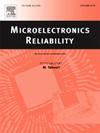10 MeV电子辐照对SiC MOSFET器件开关特性的影响
IF 1.9
4区 工程技术
Q3 ENGINEERING, ELECTRICAL & ELECTRONIC
引用次数: 0
摘要
深空探测、核电站、核潜艇等应用的严格要求,对动力器件的抗辐射性能提出了严格的要求。SiC与Si相比具有优异的耐辐射性能,但SiC功率器件在电子辐射环境中的应用仍需要进一步的理论和实验完善。特别是电子辐射对SiC功率器件开关特性影响的研究还比较缺乏。本文通过理论建模、仿真分析和10 MeV辐照实验,研究了电子辐射对SiC VDMOSFET动态和静态特性的影响。进一步分析了它们的辐射损伤机理,特别是对栅极结构和漂移区的损伤。辐射对栅极氧化物的损伤是器件特性变化的主要原因。实验结果表明,SiC MOSFET器件的辐射剂量与阈值电压之间存在非线性关系。随着辐射剂量的增加,器件的通断延迟时间和通断电压/电流变化率减小,而通断延迟时间和通断电压/电流变化率增大。因此,导通损耗的减少和导通损耗的增加会影响器件在导通过程中的热产生。我们还与Si MOSFET器件进行了比较分析。与硅MOSFET器件相比,SiC MOSFET器件的动态和静态特性受辐射的影响较小,具有更好的抗辐射性能。本文章由计算机程序翻译,如有差异,请以英文原文为准。
The impact of 10 MeV electron irradiation on switching characteristics of SiC MOSFET devices
The rigorous requirements of applications such as deep space exploration, nuclear power plants, and nuclear submarines, pose stringent demands on the radiation resistance of power devices. SiC exhibits excellent radiation resistance compared to Si, while the application of SiC power devices in electron radiation environments still requires further theoretical and experimental refinement. In particular, there is a lack of research on the impact of electron radiation on the switching characteristics of SiC power devices. In this work, we studied the electron radiation effects on the dynamic and static characteristics of SiC VDMOSFET via theoretical modeling, simulation analysis, and 10 MeV irradiation experiments. We further analyzed their radiation damage mechanisms, especially for the damage on the gate structure and drift region. Radiation-induced damage to the gate oxide is the main cause of changes in device characteristics. The experimental results demonstrate a nonlinear correlation between the radiation dose and the threshold voltage of SiC MOSFET devices. With the increase in radiation dose, the switching-on delay time and switching-off voltage/current change rate of the devices decrease, while the switching-off delay time and switching-on voltage/current change rate increase. Consequently, there is a reduction in switching-on losses and an increase in switching-off losses, which affect the thermal generation during the switching process of the device. We also conducted a comparative analysis with Si MOSFET devices. The dynamic and static characteristics of SiC MOSFET devices are found to be less affected by radiation compared to Si MOSFET devices, exhibiting superior radiation resistance.
求助全文
通过发布文献求助,成功后即可免费获取论文全文。
去求助
来源期刊

Microelectronics Reliability
工程技术-工程:电子与电气
CiteScore
3.30
自引率
12.50%
发文量
342
审稿时长
68 days
期刊介绍:
Microelectronics Reliability, is dedicated to disseminating the latest research results and related information on the reliability of microelectronic devices, circuits and systems, from materials, process and manufacturing, to design, testing and operation. The coverage of the journal includes the following topics: measurement, understanding and analysis; evaluation and prediction; modelling and simulation; methodologies and mitigation. Papers which combine reliability with other important areas of microelectronics engineering, such as design, fabrication, integration, testing, and field operation will also be welcome, and practical papers reporting case studies in the field and specific application domains are particularly encouraged.
Most accepted papers will be published as Research Papers, describing significant advances and completed work. Papers reviewing important developing topics of general interest may be accepted for publication as Review Papers. Urgent communications of a more preliminary nature and short reports on completed practical work of current interest may be considered for publication as Research Notes. All contributions are subject to peer review by leading experts in the field.
 求助内容:
求助内容: 应助结果提醒方式:
应助结果提醒方式:


